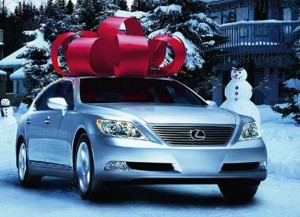The auto industry has been doing much of the heavy lifting, in recent months, helping fuel a late-2011 surge in the economy and it looks like the car market’s recovery from its worst downturn since the Great Depression is continuing into the year-end holidays.
In fact, December is on track to be the strongest month of the year, an unusual development as American consumers typically focus their spending on smaller presents they can pile up under the tree.
But if preliminary reports hold true for the month as a whole, December could see retail U.S. car sales surge past the 1 million mark for the first time since the 2009 Cash for Clunkers program, according to J.D. Power and Associates.
“The industry has managed through another series of external shocks and is in a healthier position as the year closes,” said John Humphrey, Power’s senior vice president of global automotive operations.
Relying on data provided by thousands of U.S. dealers, Power anticipates retail sales will total 1,033,700 vehicles for December, a 9% increase from the 947,821 cars, trucks and crossovers sold a year earlier. And the numbers would reflect an even more substantial 25% jump from November 2011.
Significantly, the December gain comes despite the fact that the industry, overall, has trimmed incentives 10% year-over-year to an average $2,700 a vehicle.
Power, like many analysts, focuses on the retail side of the market as automakers often manipulate fleet numbers to absorb excess production – or to inflate overall sales volumes, especially at the end of the year.
But if fleet figures are included, Power anticipates a year-over-year sales gain of 8%, with December’s tally coming in at 1,230,100 vehicles.
In part, the upturn is driven by the recovering Japanese who spent much of the year struggling to maintain production in the wake of the March 11 earthquake and tsunami that devastated the northeast corner of the island nation. While those recovery efforts were slowed by the subsequent flooding in Thailand, most Japanese-owned plants are now operating at full speed – many working extensive overtime to help dealers rebuild inventory.
“As industry-level inventory has returned to a healthy level, the need for a disciplined balance and management of supply and demand will return as well,” warned Schuster. Like many analysts, he worries the industry could see a price war break out as the Japanese struggle to regain lost ground while domestic, European and Korean marques fight to retain their recent gains.
Notably, all three of the Detroit-based manufacturers are expected to end 2011 with improved market shares, the first time that has happened since 1998. Edmunds.com predicts Chrysler will see a 37% sales gain for December alone, General Motors’ volume jumping 30.6% for the month.
For the year as a whole the auto industry is likely to be up about 10%, reaching 12.8 million, according to Edmunds’ forecast. That still will fall short of earlier predictions that had pegged 2011 as reaching the 13 million mark.
But Edmunds also issued a warning that the pace might not hold in the year ahead due to various “speed bumps.”
Among other things, analysts are unsure how much of the current sales surge is being driven by so-called “pent-up demand,” especially among Japanese brand customers who might have had to wait due to inventory shortages.
If that’s a major factor behind the current upturn it could peter out after a couple months as Japanese production returns to normal, leaving the car market struggling once again toward the second quarter of 2012. On the other hand, if more Americans are simply feeling upbeat about their own financial situation and are looking to return to the market the auto industry might just remain the big engine that could behind the U.S. economy’s revival.

